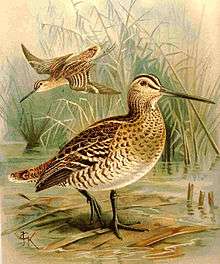Great snipe
| Great snipe | |
|---|---|
 | |
| Scientific classification | |
| Kingdom: | Animalia |
| Phylum: | Chordata |
| Class: | Aves |
| Order: | Charadriiformes |
| Suborder: | Scolopaci |
| Family: | Scolopacidae |
| Genus: | Gallinago |
| Species: | G. media |
| Binomial name | |
| Gallinago media (Latham, 1787) | |
 | |
| Range of G. media Breeding range Non-breeding range | |
| Synonyms | |
|
Capella media (Latham, 1787) | |
The great snipe (Gallinago media) is a small stocky wader in the genus Gallinago. This bird's breeding habitat is marshes and wet meadows with short vegetation in north-eastern Europe, including north-western Russia. Great snipes are migratory, wintering in Africa. The European breeding population is in steep decline.
Taxonomy
The great snipe was described by the English naturalist John Latham in 1787 with the binomial name Scolopax media.[2][3][4] The name of the current genus Gallinago is New Latin for a woodcock or snipe from Latin gallina, "hen" and the suffix -ago, "resembling". The specific media is Latin for "intermediate", because this species is intermediate in size between the woodcock and the common snipe.[5]
Description
At 26–30 cm (10–12 in) in length and a 42–50 cm (17–20 in) wingspan, adults are only slightly larger, but much bulkier, than the common snipe and have a shorter bill. The body is mottled brown on top and barred underneath. They have a dark stripe through the eye. The wings are broad, and a pale wingbar is visible in flight.
The voice is described as a faint yeah. Mating display calls of groups can be heard at long distances (more than 300 m (330 yd)) and include a rising and falling series of chirping calls and accelerating clicking noises.
Behaviour and ecology

The birds are noted for their fast, non-stop flying capabilities over huge distances.[6] They can fly up to 97 km/h (60 mph), with researchers finding little evidence of wind assistance. Some have been recorded to fly non-stop for 84 hours over 6,760 km (4,200 mi). Their wings are not especially aerodynamic, lacking pointed tips, and they typically do not stop to feed despite having opportunities. The birds instead rely on stores of fat.[6]
At dusk during the breeding season, the males display at a lek (arena), standing erect with chest puffed and tail fanned out. They may jump into the air, and will produce a variety of rattles, clicks, buzzes and whistles while displaying. Three to four eggs are laid in a well-hidden nest on the ground.
These birds forage in soft mud, probing or picking up food by sight. They mainly eat insects and earthworms, and occasional plant material. They are difficult to see, being well camouflaged in their habitat. When flushed from cover, they fly straight for a considerable distance before dropping back into vegetation.

Fossils
Fossils of the great snipe have been uncovered in North Carolina, dating back to about 4.465 Ma ±0.865M. This suggests that the bird must have at some point relocated across the Atlantic Ocean.[7]
Status
In 2012, there were estimated to be between 15,000 and 40,000 great snipe in Scandinavia and between 450,000 and 1,000,000 in western Siberia and northeastern Europe. The species is experiencing a population decline, owing primarily to habitat loss, as well as to hunting in eastern Europe and in its African wintering range. The species is classified by the International Union for Conservation of Nature as "Near Threatened".[1] The great snipe is one of the species to which the Agreement on the Conservation of African-Eurasian Migratory Waterbirds (AEWA) applies.[8]
References
- 1 2 BirdLife International (2012). "Gallinago media". IUCN Red List of Threatened Species. Version 2013.2. International Union for Conservation of Nature. Retrieved 26 November 2013.
- ↑ Latham, John (1787). Supplement to the General synopsis of birds. London: Leigh & Sotheby. p. 292.
- ↑ Latham, John (1785). A general synopsis of birds. Volume 3 Part 1. London: Leigh & Sotheby. p. 133.
- ↑ Peters, J.L, ed. (1934). Check-list of Birds of the World. Volume 2. Cambridge, Massachusetts: Museum of Comparative Zoology. p. 275.
- ↑ Jobling, James A (2010). The Helm Dictionary of Scientific Bird Names. London: Christopher Helm. pp. 170, 244. ISBN 978-1-4081-2501-4.
- 1 2 Klaassen, Raymond H.G.; Alerstam, Thomas; Carlsson, Peter; Fox, James W.; Lindström, Åke (25 May 2011). "Great flights by great snipes: long and fast non-stop migration over benign habitats". Biology Letters. 7 (6). doi:10.1098/rsbl.2011.0343.
- ↑ "†Capella media Latham 1787 (snipe)". Fossilworks: Gateway to The Paleobiology Database. 3 January 2009. Retrieved 13 February 2016.
- ↑ "Agreement Text and Annexes" (PDF). Agreement on the Conservation of African - Eurasian Migratory Waterbirds (AEWA). November 2015. Retrieved 25 June 2016.
Further reading
- Lindström, Å.; Alerstam, T.; Bahlenberg, P.; Ekblom, R.; Fox, J.W.; Råghall, J.; Klaassen, R.H.G. (2016). "The migration of the great snipe Gallinago media: intriguing variations on a grand theme". Journal of Avian Biology. 47 (3): 321–334. doi:10.1111/jav.00829.

- Løfaldli, L.; Kålås, J.A.; Fiske, P. (1992). "Habitat selection and diet of Great Snipe Gallinago media during breeding". Ibis. 134 (1): 35–43. doi:10.1111/j.1474-919X.1992.tb07227.x.
External links
| Wikimedia Commons has media related to Gallinago media. |
| Wikispecies has information related to: Gallinago media |
- Great snipe at Handbook of Birds of the World (subscription required)
- BirdLife species factsheet for Gallinago media
- "Gallinago media". Avibase.

- "Great snipe media". Internet Bird Collection.
- Great snipe photo gallery at VIREO (Drexel University)
- Interactive range map of Gallinago media at IUCN Red List maps
- Audio recordings of Great snipe on Xeno-canto.
- Gallinago media in the Flickr: Field Guide Birds of the World
- Great snipe media at ARKive

